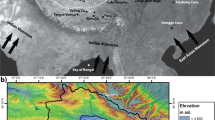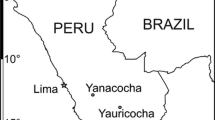Abstract
Weather variation and climate fluctuations are the main sources of ecosystem variability in remote mountain lakes. Here we describe the main patterns of seasonal variability in the ecosystems of nine lakes in Europe, and discuss the implications for recording climatic features in their sediments. Despite the diversity in latitude and size, the lakes showed a number of common features. They were ice-covered between 5–9 months, and all but one were dimictic. This particular lake was long and shallow, and wind action episodically mixed the water column throughout the ice-free period. All lakes showed characteristic oxygen depletion during the ice-covered-period, which was greater in the most productive lakes. Two types of lakes were distinguished according to the number of production peaks during the ice-free season. Lakes with longer summer stratification tended to have two productive periods: one at the onset of stratification, and the other during the autumn overturn. Lakes with shorter stratification had a single peak during the ice-free period. All lakes presented deep chlorophyll maxima during summer stratification, and subsurface chlorophyll maxima beneath the ice. Phosphorus limitation was common to all lakes, since nitrogen compounds were significantly more abundant than the requirements for the primary production observed. The major chemical components present in the lakes showed a short but extreme dilution during thawing. Certain lake features may favour the recording of particular climatic fluctuations, for instance: lakes with two distinct productive periods, climatic fluctuations in spring or autumn (e.g., through chrysophycean cysts); lakes with higher oxygen consumption, climatic factors affecting the duration of the ice-cover (e.g., through low-oxygen tolerant chironomids); lakes with higher water retention time; changes in atmospheric deposition (e.g., through carbon or pigment burial); lakes with longer stratification, air temperature changes during summer and autumn (e.g., through all epilimnetic species).
Similar content being viewed by others
References
Armitage, P., P. S. Cranston & L. C. V. Pinder (eds), 1995. The Chironomidae. Biology and Ecology of non-biting midges. Chapman & Hall, London, UK, 572 pp.
Barbieri, A. & R. Mosello, 2000. Recent trends in chemistry, and mass budget of high altitude lake in the southern Alps (Laghetto Inferiore, Cantone Ticino, Switzerland). J. Limnol. 59: 103-112.
Battarbee, R. W., J.-A. Grytnes, R. Thompson, P. G. Appleby, J. Catalan, A. Korhola, H. J. B. Birks, E. Heegaard & A. Lami, 2002. Comparing palaeolimnological and instrumental evidence of climate change for remote mountain lakes over the last 200 years. J. Paleolim. 28: 161-179.
Brancelj, A., M. Šiško, G. Muri, P. Appleby, A. Lami, E. Shilland, N. L. Rose, C. Kamenik, S. J. Brooks & J. A. Dearing, 2002. Lake Jezero v Ledvici (NW Slovenia)-changes in sediment records over the last two centuries. J. Paleolim. 28: 47-58.
Catalan, J., 1988. Physical properties of the environment relevant to the pelagic ecosystem dynamics of a deep high-mountain lake (Estany Redó, Central Pyrenees). Oecol. Aquat. 9: 80-123.
Catalan, J., 1989. The winter cover of a high-mountain Mediterranean lake (Estany Redó, Pyrenees). Water Resour. Res. 25: 519-527.
Catalan, J., 1991. The relationship between the functional anatomy of lakes and primary production. Oecol. Aquat. 10: 77-94.
Catalan, J., 1992. Evolution of dissolved and particulate matter during the ice-covered period in a deep high-mountain lake. Can. J. Fish. aquat. Sci. 49: 945-955.
Catalan, J., 2000. Primary production in a high mountain lake: an overview from minutes to kiloyears. Att. Assoc. Ital. Oceanol. Limnol. 13: 1-21.
Catalan, J. & L. Camarero, 1991. Ergoclines and biological processes in high-mountain lakes: similarities between the summer stratification and the ice-forming period in lake Redó (Pyrenees). Verh. Int. Verein. Limnol. 24: 1011-1015.
Catalan, J. & L. Camarero, 1993. Seasonal changes in pH and alkalinity in two Pyrenean high-mountain lakes. Verh. Int. Verein. Limnol. 25: 749-753.
Catalan, J., S. Pla, M. Rieradevall, M. Felip, M. Ventura, T. Buchaca, L. Camarero, A. Brancelj, P. G. Appleby, A. Lami, J. A. Grytnes, A. Agustí-Panareda & R. Thompson, 2002. Lake Redó ecosystem response to an increasing warming in the Pyrenees during the twentieth century. J. Paleolim. 28: 129-145.
Douglas, M. S. V. & J. P. Smol, 1999. Freshwater diatoms as indicators of environmental change in the High Arctic. In E. F. Stoermer, J. P. Smol (eds), The Diatoms: Application for the Environmental and Earth Sciences. Cambridge University Press, Cambridge, UK, 227-244.
Felip, M., F. Bartumeus, S. Halac & J. Catalan, 1999. Microbial plankton assemblages, composition and biomass, during two ice-free periods in a deep high mountain lake (Estany Redó, Pyrenees). J. Limnol. 58: 193-202.
Felip, M. & J. Catalan, 2000. The relationship between phytoplankton biovolume and chlorophyll in a deep oligotrophic lake: decoupling in their spatial and temporal maxima. J. Plankton Res. 22: 91-105.
Fott, J., M. Blazo, E. Stuchlík & O. Strunecký, 1999. Phytoplankton in three Tatra Mountain lakes of different acidification status. J. Limnol. 58: 107-116.
Goudsmit, G.-H., G. Lemcke, D. M. Livingstone, A. F. Lotter, B. Müller & M. Sturm, 2000. Hagelseewli: a fascinating mountain lake-suitable for palaeoclimate studies? Verh. Int. Verein. Limnol. 27: 1013-1022.
Granados, I. & M. Toro, 2000. Recent warming in a high mountain lake (Laguna Cimera, Central Spain) inferred by means of fossil chironomids. J. Limnol. 59(suppl 1): 109-119.
Guilizzoni, P., A. Lami & A. Marchetto, 1992. Plant pigment ratios from lake sediments as indicators of recent acidification in alpine lakes. Limnol. Oceanogr. 37: 1565-1569.
Imberger, J. & J. C. Patterson, 1990. Physical limnology. Adv. Appl. Mech. 27: 303-375.
Jeffrey, S. W. & G. F. Humphrey, 1975. New spectrophotometric equations for determining chlorophyll a, b, c1, and c2 in higher plants, algae and natural phytoplankton. Biochem. Physiol. Pflanzen. 167: 191-194.
Koinig, K. A., N. Büsing, A. Wille, B. Sattler, R. Schmidt & R. Psenner, 2000. Diatom communities in the ice cover of an alpine lake-their influence on pH reconstruction from fossil diatom assemblages. Verh. Int. Verein. Limnol. 27: 1203.
Livingstone, D. M., 1997. Break-up dates of alpine lakes as proxy data for local and regional mean surface air temperatures. Clim. Change 37: 407-439.
Livingstone, D. M., A. F. Lotter & I. R. Walker, 1999. The decrease in summer surface water temperature with altitude in Swiss Alpine lakes: a comparison with air temperature lapse rates. Arctic Antarctic Alpine Res. 31: 341-352.
Lotter A. F., I. R. Walker, S. J. Brooks & W. Hofmann, 1999. An intercontinental comparison of chironomid palaeotemperature inference models: Europe vs North America. Quat. Sci. Rev. 18: 717-735.
Margalef, R., 1983. Limnología. Omega, Barcelona, Spain, 1010 pp.
Nickus, U., H. Thies, M. Kuhn & R. Psenner, 1998. The snow cover at a headwater site in the Tyrolean Alps: seasonal and local variability of atmospheric trace substances in the snow pack. In Tappeiner, U., F. V. Ruffini & M. Fumai (eds), HeadWater '98: Hydrology, Water Resources and Ecology of Mountain Areas. IAHS Publ., 39-42.
Pla, S., 1999. Chrysophycean cysts from the Pyrenees and their applicability as palaeoenvironmental indicators. Ph.D. thesis, University of Barcelona, Barcelona, Spain, 277 pp.
Psenner, R. & J. Catalan, 1994. Chemical composition of lakes in crystalline basins: a combination of atmospheric deposition, geologic background, biological activity, and human action. In Margalef. R. (ed.), Limnology Now, A Paradigm of Planetary Problems. Elsevier, Amsterdam, The Netherlands, 255-314.
Redfield, A. C., B. H. Ketchum & E. A. Richards, 1963. The influence of organisms on the composition of sea-water. In Hill, M. N. (ed.), The Sea. Ideas and Observations in the Study of the Seas. Vol. 2. John Wiley & Sons, New York, 26-77.
Reynolds, C. S., 1997. Vegetation processes in the pelagic: a model for ecosystem theory. Ecology Institute, Oldendorf/Luhe, Germany, 371 pp.
Schindler, D. W., 1997. Widespread effects of climatic warming on freshwater ecosystems in North America. Hydrolog. Proc. 11: 1043-1067.
Schmidt, W., 1928. Ñber Temperatur-und Stabilitätsverhältnisse von Seen. Geogr. Ann. 10: 145-177.
Simona, M., A. Barbieri, M. Veronesi, S. Malusardi, V. Straškrabová, 1999. Seasonal dynamics of plankton in a mountain lake in the southern Alps (Laghetto Inferiore, Switzerland). J. Limnol. 58: 169-178.
Sommaruga-Wölgrath, S., K. A. Koinig, R. Schmidt, R. Sommaruga, R. Tessadri & R. Psenner, 1997. Temperature effects on the acidity of remote alpine lakes. Nature 387: 64-67.
Straškrabová, V., C. Callieri & J. Fott (eds), 1999a. Pelagic food web in mountain lakes (MOuntain LAkes Research program). J. Limnol. 58.
Straškrabová, V., C. Callieri, P. Carrillo, L. Cruz-Pizarro, J. Fott, P. Hartman, M. Macek, J. M. Medina-Sánchez, J. Nedoma & K. Šimek, 1999b. Investigations on pelagic food webs in mountain lakes-aims and methods. J. Limnol. 58: 77-87.
Stumm, W. & J. J. Morgan, 1981. Aquatic Chemistry. John Wiley & Sons. New York, 780 pp.
The MOLAR Water Chemistry Group, 1999. The MOLAR project: atmospheric deposition and lake water chemistry. J. Limnol. 58: 88-106.
Thies, H., U. Nickus & R. Psenner, 1998. Response of discharge and water quality in headwater brooks on distinct hydroclymatic conditions in the Tyrolean Alps. In Hydrology, water resources and ecology in headwaters. Proceedings of the HeadWater'98 Conference. IAHS Publ. 248: 491-497.
Thies, H., U. Nickus, C. Arnold, R. Schnegg, A. Wille & R. Psenner, 2000. Biogeochemistry of a high mountain lake in the Austrian Alps. Verh. Int. Verein. Limnol. 27: 4513-4516.
Ventura, M., L. Camarero, T. Buchaca, F. Bartumeus, D. M. Livingstone & J. Catalan, 2000. Main features of the seasonal variability in the external forcing and dynamics of a deep mountain lake (Redó, Pyrenees). J. Limnol. 59(suppl. 1): 97-108.
Wathne, B. M. & H. E. Hansen, 1997. MOLAR. Measuring and modelling the dynamic response of remote mountain lake ecosystems to environmental change: a programme of mountain lake research. MOLAR Project Manual. NIVA, Report O-96061.
Williams, D. D. & B. W. Feltmate, 1992. Aquatic Insects. CAB International, Wallingford, UK, 358 pp.
Author information
Authors and Affiliations
Rights and permissions
About this article
Cite this article
Catalan, J., Ventura, M., Brancelj, A. et al. Seasonal ecosystem variability in remote mountain lakes: implications for detecting climatic signals in sediment records. Journal of Paleolimnology 28, 25–46 (2002). https://doi.org/10.1023/A:1020315817235
Issue Date:
DOI: https://doi.org/10.1023/A:1020315817235




